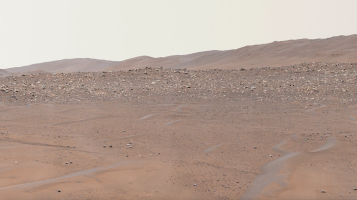Main image - maximum resolution version, 94000 x 25328 pixels (.tif, 2.96 GB)
Main image - half maximum resolution version, 47000 x 12664 pixels (.jpg, 171 MB)

Figure A - Enhanced ColorFigure A image - maximum resolution version, 94000 x 25328 pixels (.tif, 3.23 GB)
Figure A image - half maximum resolution version, 47000 x 12664 pixels (.jpg, 240 MB)

Figure B - VideoFigure B - Click here for animation (.mp4, 152 MB)

Figure C - AnaglyphFigure C image - maximum resolution version, 94000 x 25328 pixels (.tif, 2.47 GB)
Figure C image - half maximum resolution version, 47000 x 12664 pixels (.jpg, 154 MB)

Figure D - AnnotatedFigure D image - 12670 x 3835 pixels (.png, 82 MB)
Composed of 993 individual images and 2.38 billion pixels, this 360-degree mosaic taken by NASA's Perseverance looks in all directions from a location the rover science team calls "Airey Hill." The rover remained parked at Airey Hill during the entirety of solar conjunction.
Captured by the rover's Mastcam-Z, the images used to create the mosaic were acquired on Nov. 3, Nov. 4, and Nov. 6, 2023, the 962nd, 963rd, and 965th Martian day, or sol, of the rover's mission. The main image is a natural color version at half-resolution.
Figure A is an enhanced-color view of the mosaic. The color bands of the image have been processed to improve visual contrast and accentuate color differences.
Figure B is a 60-second video that pans across the mosaic.
Figure C shows the mosaic, now composed of 1,926 images, in an anaglyph that can be viewed with red-blue 3D glasses.
Figure D is an annotated version of the enhanced-color view (Figure A) indicating a potential future track for Perseverance, including its route out of Jezero Crater.
Arizona State University leads the operations of the Mastcam-Z instrument, working in collaboration with Malin Space Science Systems in San Diego, on the design, fabrication, testing, and operation of the cameras, and in collaboration with the Niels Bohr Institute of the University of Copenhagen on the design, fabrication, and testing of the calibration targets.
A key objective for Perseverance's mission on Mars is astrobiology, including the search for signs of ancient microbial life. The rover will characterize the planet's geology and past climate, pave the way for human exploration of the Red Planet, and be the first mission to collect and cache Martian rock and regolith (broken rock and dust).
Subsequent NASA missions, in cooperation with ESA (European Space Agency), would send spacecraft to Mars to collect these sealed samples from the surface and return them to Earth for in-depth analysis.
The Mars 2020 Perseverance mission is part of NASA's Moon to Mars exploration approach, which includes Artemis missions to the Moon that will help prepare for human exploration of the Red Planet.
NASA's Jet Propulsion Laboratory, which is managed for the agency by Caltech in Pasadena, California, built and manages operations of the Perseverance rover.
For more about Perseverance: mars.nasa.gov/mars2020/

